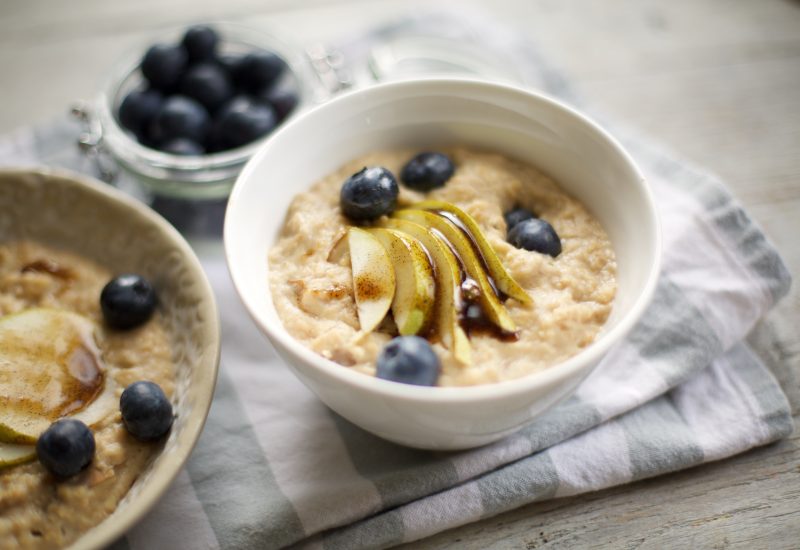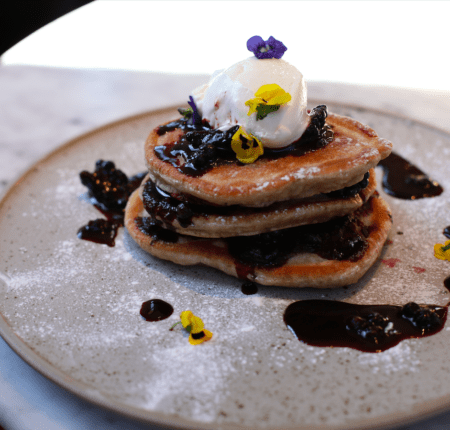There’s nothing more enjoyable than a steaming bowl of porridge on a cold morning. This is one of my breakfast favourites as it’s so filling, versatile, and easy to whip up. Porridge can be made with a variety of grains, vegetables and even legumes, but oats are most commonly used and that’s why porridge is often referred to as oatmeal. These may be combined with water but you’ll probably prefer to mix them with milk (either cow’s or a plant-based variety) if you want a creamier consistency. Then you can add all the toppings you like! From fresh fruit and chopped nuts, to syrups and chocolate, porridge never gets boring. And it’s a great way to start your day because it provides slow-releasing energy throughout the morning, keeping you full until lunch. This really is one of the most healthy and delicious breakfasts you can have, but if you need any more convincing, here are four reasons porridge is good for you — and four of my favourite recipes!
1. Porridge is incredibly nutritious
Porridge is one of the most nutritious foods available. For starters, it’s an excellent source of carbohydrates for energy and fibre to aid digestion. In fact, one bowl of porridge provides more fibre than a slice of wholemeal bread — one reason to swap your morning toast for some oats from time to time. It also includes healthy fats that are an essential part of a balanced diet.
Overall, one cooked cup of porridge (39 grams) in water with no added salt or sugar has 28g carbs, 2.5g fat, 0g sugar, and is just 140 calories. Compare this to a serving of granola which contains 200 calories, 32g carbs, 10g sugar and 4-7g fat. Porridge clearly comes out on top if you’re looking to reduce your fat, sugar and calorie intake. It’s also rich in minerals including iron, copper, and manganese, with iron benefiting your metabolism and aiding oxygen transport, copper helping maintain healthy bones, and manganese supporting blood sugar management. You can get even more nutrients by loading your porridge with fruit like berries or bananas to help reach your five-a-day, and increase its fibre and healthy fat content with flax seeds or hemp seeds.
My porridge recommendation
For an extra boost in the morning, try my sweet espresso oats.
2. Porridge can lower cholesterol levels
High cholesterol is linked to heart disease, one of the leading causes of death. We can help regulate cholesterol through our diet, and porridge is one food that can have a positive impact. This is because it contains beta-glucan, a form of fibre, which enters your gut and binds to cholesterol-rich bile acids produced to aid digestion. This increases the excretion of bile and naturally reduces circulating levels of cholesterol, slowing down your body’s absorption of fat. Studies have found that just 3g or more of beta-glucan a day can help lower your cholesterol levels, and a 40g bowl of porridge contains 2g. This doesn’t mean you need to eat more than one portion a day though — beta-glucan is found in other foods including shiitake mushrooms, barley, and seaweed.
My porridge recommendation
This gingerbread and apple porridge is the perfect warming bowl of goodness when it’s cold out.
3. Porridge aids weight loss
Give thanks to beta-glucan once again, as this super fibre means porridge can also help with weight loss. Beta-glucan is responsible for delaying the time it takes for the stomach to empty its contents, meaning you’ll feel fuller for longer and less likely to snack in between meals. As such, eating porridge regularly can help you
maintain or even lose weight over time, depending on the rest of your diet of course. What’s more, oats respond well to insulin, helping to improve insulin sensitivity. This is important if you’re trying to lose weight because insulin sensitivity helps prevent blood sugar crashes which trigger hunger, and may cause you to eat more.
Porridge is even more delicious with toppings and I love experimenting with different combinations. But if weight loss is your personal goal, be mindful of how many you’re putting on so you don’t end up consuming far more calories than you mean to. For example, one teaspoon of peanut butter has 31 calories while a tablespoon has 94.
My porridge recommendation
If you love peanut butter, try out my protein porridge recipe.
4. Porridge helps balance blood sugar levels
Eating porridge can help you regulate your blood sugar levels as the fibre delays when glucose is absorbed into your blood flow. Porridge is a low GI food, meaning it scores low on the glycemic index, which corresponds to the fact that it takes longer to digest and is less likely to cause blood sugar spikes and dips. Beta-glucan also reduces glucose and insulin responses after meals which helps to improve your insulin sensitivity, so you’ll require less insulin when eating. Low sensitivity means more insulin is needed, and this can lead to problems such as prediabetes, type two diabetes, and heart attacks. As well as tasting delicious, eating porridge gives you the benefit of better glycemic control.
My porridge recommendation
Try out my overnight oats containing a yummy mix of coconut, macadamia, and apple. You’ll find plenty more healthy and delicious porridge ideas in my selection of breakfast recipes







